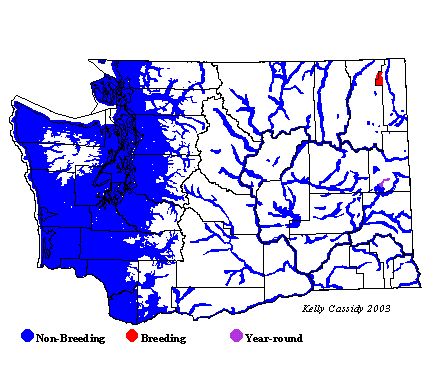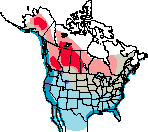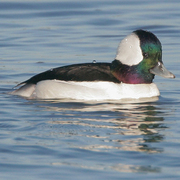Bufflehead
General Description
Washington's smallest diving duck, the Bufflehead, is easily distinguished from other ducks. The male has a white underside and a dark back that appears black, but upon closer inspection, is actually a deep iridescent greenish-purple. At the back of the black head is a wedge of white. This mark distinguishes the Bufflehead from the larger goldeneyes, which have white in front of their eyes. The smaller female is a drab, brownish, dusty-black with white ear- and wing-patches.
Habitat
Buffleheads' breeding habitat is small lakes and ponds in boreal forests with nearby stands of poplar and aspen. In the winter, they are most often found in coastal areas in shallow bays and inlets.
Behavior
Aggressive and monogamous during the breeding season, Buffleheads sometimes keep the same mate, and often the same nest, for several years. Females almost always return to their hatch-sites to breed. Territorial disputes between females with young often end up with the winning female going away with more or perhaps all of the young. Buffleheads have numerous elaborate courtship displays that they perform throughout the year, except during the post-breeding molt and in the early fall.
Diet
When nesting, Buffleheads eat mostly insect larvae and other invertebrates. In winter, their diet shifts to crustaceans and mollusks. They dive and swallow their prey under water.
Nesting
Buffleheads nested historically in abandoned flicker holes, which are too small for other cavity-nesting ducks. They now also nest in man-made boxes. Nests are located within 25 yards of the water and from 2 to 42 feet above the ground. The female uses enough down to cover the eggs but adds no other material. She lays a median of 9 eggs, which she incubates alone. Once the young hatch, the female continues to care for them, although they are able to feed themselves almost immediately.
Migration Status
Birds found in Washington in winter come from many western breeding areas. The birds arrive in Washington in late October to early November. Like many ducks, Buffleheads migrate at night.
Conservation Status
Buffleheads are among the few species of ducks whose numbers have dramatically increased since the mid-1950s when over-hunting was a significant factor. Protection from and regulation of hunting have helped these birds. Habitat degradation, on the other hand, has eliminated nesting habitat. The tendency of females to return to the areas where they were hatched makes it difficult to repopulate an area once a population is gone. Populating a new area is similarly difficult.
When and Where to Find in Washington
In winter, densities of Bufflehead are high in sheltered bays and inlets throughout the state's coastal areas. They also winter on fresh water in smaller numbers. In the breeding season, they rarely breed in the northeastern corner of the state. They have recently been recorded breeding at Big Meadow Lake (Pend Orielle County), and the Turnbull National Wildlife Refuge (Spokane County). Washington is at the southwestern edge of their breeding range, but non-breeders can be spotted in the summer throughout the state.
 Abundance
Abundance
| Ecoregion | Jan | Feb | Mar | Apr | May | Jun | Jul | Aug | Sep | Oct | Nov | Dec |
|---|---|---|---|---|---|---|---|---|---|---|---|---|
| Oceanic | ||||||||||||
| Pacific Northwest Coast | C | C | C | C | F | R | R | R | R | C | C | C |
| Puget Trough | C | C | C | C | C | R | R | R | U | C | C | C |
| North Cascades | C | C | C | C | U | C | C | |||||
| West Cascades | C | C | C | C | F | R | F | C | C | |||
| East Cascades | C | C | C | C | U | R | U | F | C | C | ||
| Okanogan | U | C | C | C | F | R | R | R | R | C | C | C |
| Canadian Rockies | F | F | F | F | U | R | R | R | F | F | F | F |
| Blue Mountains | R | R | R | R | ||||||||
| Columbia Plateau | C | C | C | C | F | R | R | R | R | C | C | C |
Washington Range Map

North American Range Map


Family Members
 Fulvous Whistling-DuckDendrocygna bicolor
Fulvous Whistling-DuckDendrocygna bicolor Taiga Bean-GooseAnser fabalis
Taiga Bean-GooseAnser fabalis Greater White-fronted GooseAnser albifrons
Greater White-fronted GooseAnser albifrons Emperor GooseChen canagica
Emperor GooseChen canagica Snow GooseChen caerulescens
Snow GooseChen caerulescens Ross's GooseChen rossii
Ross's GooseChen rossii BrantBranta bernicla
BrantBranta bernicla Cackling GooseBranta hutchinsii
Cackling GooseBranta hutchinsii Canada GooseBranta canadensis
Canada GooseBranta canadensis Mute SwanCygnus olor
Mute SwanCygnus olor Trumpeter SwanCygnus buccinator
Trumpeter SwanCygnus buccinator Tundra SwanCygnus columbianus
Tundra SwanCygnus columbianus Wood DuckAix sponsa
Wood DuckAix sponsa GadwallAnas strepera
GadwallAnas strepera Falcated DuckAnas falcata
Falcated DuckAnas falcata Eurasian WigeonAnas penelope
Eurasian WigeonAnas penelope American WigeonAnas americana
American WigeonAnas americana American Black DuckAnas rubripes
American Black DuckAnas rubripes MallardAnas platyrhynchos
MallardAnas platyrhynchos Blue-winged TealAnas discors
Blue-winged TealAnas discors Cinnamon TealAnas cyanoptera
Cinnamon TealAnas cyanoptera Northern ShovelerAnas clypeata
Northern ShovelerAnas clypeata Northern PintailAnas acuta
Northern PintailAnas acuta GarganeyAnas querquedula
GarganeyAnas querquedula Baikal TealAnas formosa
Baikal TealAnas formosa Green-winged TealAnas crecca
Green-winged TealAnas crecca CanvasbackAythya valisineria
CanvasbackAythya valisineria RedheadAythya americana
RedheadAythya americana Ring-necked DuckAythya collaris
Ring-necked DuckAythya collaris Tufted DuckAythya fuligula
Tufted DuckAythya fuligula Greater ScaupAythya marila
Greater ScaupAythya marila Lesser ScaupAythya affinis
Lesser ScaupAythya affinis Steller's EiderPolysticta stelleri
Steller's EiderPolysticta stelleri King EiderSomateria spectabilis
King EiderSomateria spectabilis Common EiderSomateria mollissima
Common EiderSomateria mollissima Harlequin DuckHistrionicus histrionicus
Harlequin DuckHistrionicus histrionicus Surf ScoterMelanitta perspicillata
Surf ScoterMelanitta perspicillata White-winged ScoterMelanitta fusca
White-winged ScoterMelanitta fusca Black ScoterMelanitta nigra
Black ScoterMelanitta nigra Long-tailed DuckClangula hyemalis
Long-tailed DuckClangula hyemalis BuffleheadBucephala albeola
BuffleheadBucephala albeola Common GoldeneyeBucephala clangula
Common GoldeneyeBucephala clangula Barrow's GoldeneyeBucephala islandica
Barrow's GoldeneyeBucephala islandica SmewMergellus albellus
SmewMergellus albellus Hooded MerganserLophodytes cucullatus
Hooded MerganserLophodytes cucullatus Common MerganserMergus merganser
Common MerganserMergus merganser Red-breasted MerganserMergus serrator
Red-breasted MerganserMergus serrator Ruddy DuckOxyura jamaicensis
Ruddy DuckOxyura jamaicensis

